|
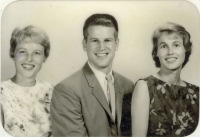
Ann, John, Lucy Freehafer-1963
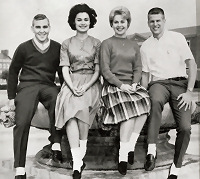
SMU Freshman Class Officers-(1961-62)
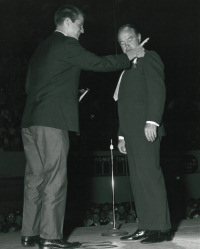
John & Bob Hope-SMU Convocation
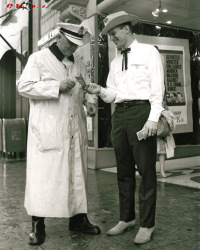
John Promoting "Wheeler Dealer"
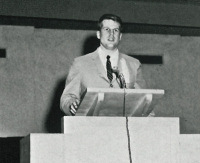
John as President of Cycen Fjodr
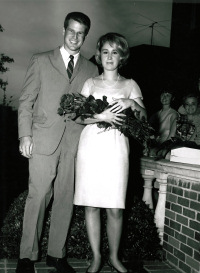
John & Carrie Walters-Sorority House-SMU
|
|
Introduction:
After our wonderful 50th Reunion of the WLHS Class of 1961, I found myself
shaken as did many of you at the large number of our classmates who were
no longer with us.
As we had shared so many thoughts and memories that weekend about our
lives in high school and beyond, I was saddened that when you went to Jim
Dammon’s wonderful website, and clicked on the names of our friends who
were gone, many were represented by a blank page.
This led me to a reconnection with Lucy Freehafer Wold (WLHS ’56), John's
sister, and a rather remarkable correspondence about John and his family,
and especially the story of his life after West Lafayette. John only got
41/2 years after we graduated, but as expected, he lived those years,
fully and passionately, with great verve and joy. I asked Lucy if she
would be willing to share some of her thoughts and memories of John with
us as a class, and the following is her response. Tom Moore
John Lytle Freehafer
February 12, 1943 – October 6, 1965
Remembering John
BY LUCY FREEHAFER WOLD
A Sister Remembers
An invitation to put some words and pictures about John’s life following
high school graduation on your extraordinary class website led me on a
journey I never expected to take. Doing so enabled me to realize that Tom
Moore is right –only in facing the painful chapter can the many happy
chapters be recaptured. Perhaps what you find here will help you
recapture some high school memories you have forgotten. You were all a
part of, and added so much to, John’s growing up years. He spoke often
about so many of you and was quite introspective in letters he wrote as
college was drawing to a close about those vulnerable yet somehow
invincible years spent in West Lafayette. Thank you for your role in his
life. He did not grow older as the rest of us have, so our memories of him
remain in that tender time of youth, dear on some level to each of us.
During the summer between high school graduation and the beginning of
college, John wondered if he was making the right decision in going so far
from the home where he had lived since he was ten. He was leaving all that
was safe and familiar to him – family, WLHS classmates, teachers, coaches
and even school administrators. He had been surrounded his whole childhood
by people who loved him and supported his growth. It was scary to be
heading for The Big D and Southern Methodist University where he really
knew no one. As he looked with some trepidation at the academic side of
college, I remember making a little booklet for him highlighting the
importance of PQ (Personality Quotient). I knew, as perhaps he did not,
that his personality and ability to win friends would carry him far
wherever he went.
Freshman Year
Fortunately, John’s worries proved to be unfounded because Dallas and SMU
quickly embraced him as one of their own. He absolutely thrived during his
college years. He chose to major in Finance and Economics, and after a few
false starts, buckled down to work and never looked back. He joined Phi
Delta Theta fraternity, and later in the semester ran for and was elected
the university freshman class president. He had become smitten with
politics at age thirteen after attending the Democratic National
Convention in Chicago with his father in 1956. He totally loved all the
hullabaloo that took place on the convention floor. I remember him coming
into the house when he returned from Chicago shouting, And now from the
Great State of Freehafer! We had to put up with a lot of political
posturing before he came back down to reality. That “fire” never left him.
When he was twenty-one John served as a page at the Democratic National
Convention of 1964, in Atlantic City. His dream was to one day have a life
in politics. He always referred to himself as a proud American and a proud
Democrat.
He realized he was off to a good start when he was “tapped” as a serf for
SMU’S secret society, the Knighthood of Cycen Fjodr, founded in 1915. It
is said to be the oldest honorary at the university and the only
fraternity of its kind in the United States. During Homecoming weekend
every fall, the knights, who are seniors, tap ten serfs from the freshman
class based on high school records, interview performance and early
success on the campus. They are picked with the hope that these men will
become the knights in their senior year. John was very excited to be
tapped in his freshman year, and indeed in his senior year not only became
a knight, but president of Cycen Fjodr as well.
Sophomore Year
With a year of campus life behind him, John’s plunged into activities
focusing on supporting SMU and helping it become a better place for
students. He sought financial help for the university from Dallas
businesses, served as Election Rally Chairman supporting candidates
seeking to better SMU and was selected to join a group of men whose
mission was to promote school spirit
John loved people–all kinds of people–anywhere and everywhere. Sometimes
he would go stand on a busy street corner in Dallas, not because he needed
to be there, but just to observe the people who passed. They fascinated
him. This curiosity about people is one of the reasons he always longed to
travel. During the summer between his sophomore and junior year, he spent
a month traveling in Europe and returned with a full beard, a big smile,
and lots of stories to tell. He also had the opportunity to see the New
York World’s Fair in 1964. These trips captivated him, and I think they
whetted his appetite for more travel to other lands he had only read about
in books.
Junior Year
A couple of months into his junior year, John, like everyone else in
America, was devastated by the Kennedy assassination. He writes, “ I went
out to the airport to see JFK when he came in about 11:30. There was a big
friendly cheering crowd out there to meet him—there were no anti-Kennedy
signs to be seen anywhere. He and Jackie both seemed very relaxed and
happy. Both walked right into the crowd where I was standing, shaking
hands and smiling. I did not get close enough to shake hands, but I think
I might have gotten a pretty good picture of him.” He later adds,” I still
have a hard time believing he is dead. God, what a waste of a fabulous
human being.” He was grief stricken. (Two years later when John died, I
remembered his words, and repeated them over and over about him.)
As a junior, John became editor of The SMU Campus student newspaper. He
wrote a weekly column entitled It Happened Tuesday Night reporting on
actions taken by the student senate. He was chair of the Student Senate
Election Committee and Co-chair of Homecoming. In a change of pace John
got a job doing what he called “the craziest thing I have ever done.” MGM
in Dallas called SMU to see if they had a student who looked like a Texan.
Since John looked more like a Texan than most Texans, he was asked to don
western gear and stand in front of a Dallas movie theater selling dollar
bills for fifty cents to advertise the James Garner film Wheeler Dealer.
Not surprisingly, he loved it!
Senior Year
John’s drive to excel continued into his final year at SMU. He was sports
editor of the student yearbook, The Rotunda, and was chosen as a Senior
Superlative, one of ten seniors who “made the most significant
contributions to the University.” He was also a winner of the “M” Award,
the most highly coveted recognition bestowed upon graduating seniors and
was in Who’s Who among Students in American Universities and Colleges.
Perhaps most noteworthy was his election as president of both SMU top
men’s honoraries, Cycen Fjodr and Blue Key. Another fun and rewarding
opportunity of his senior year was appearing on stage with Bob Hope at one
of the student convocations.
During his senior year, John roomed in a residence off campus with three
of his fraternity brothers. Because it was on Rankin Street, it was
notoriously known as “Rank Inn.” The first day of the second semester,
their place burned down because clothing was left on top of a floor
furnace. Fortunately, no one was hurt but the boys lost almost all of
their belongings. They found a new apartment and swore to keep the “Rank
Inn” image alive. John told a newspaper reporter, “We’re calling our new
place the ‘Gross Out’ since the ‘Rank Inn’ seems to have been ill-fated.
Then he added, In the words of Ralph Waldo Emerson, ‘Our greatest glory
consists not in never falling, but in rising every time we fall.”
John graduated from SMU in May of 1965.
From the SMU Yearbook, The Rotunda
John Freehafer is a Finance major from West Lafayette, Indiana. John is
the first man in the history of the University to serve as President of
the two top men’s honoraries, Cycen Fjodr and Blue Key. He has served as
chairman of the Student Election committee, the Student Academic Endowment
Committee, and 1963 Homecoming. He was President of his freshman class, a
member of Phi Delta Theta, Squires, Rotunda Sports Editor, and Who’s Who.
Following a Life-long Dream
From the Lafayette Journal and Courier (1965)
A dream he has had since he was nine will become a reality soon for John
Lytle Freehafer, a 1961 West Lafayette High School graduate. That dream is
a year-long trip around the world.
John’s words (taken from his tape recorder)
What does it feel like when you finish packing one large suitcase that is
to be all your protection from the elements for an entire year’s trip
around the world? It is an indescribable feeling I can assure you. It is
even more of an eerie feeling to say goodbye to your loving parents who
have been so tolerant of your wild adventurous dreams, and who you will
not lay eyes on again for one tenth of a decade. All this at a somewhat
tender age of twenty-two.
I left my home in West Lafayette, Indiana, a beautiful little community on
the banks of the Wabash River, 90% of whose citizenry live and die for O’
Purdue University located within its boundaries. On July 1st, 1965, in
search of adventure, in somewhat paradoxical peace of mind, I was armed
with one large air force flight bag containing all my worldly possessions;
two suits, three pairs of pants, five shirts, three pairs of shoes, socks,
underwear, one camera, and one tape recorder. Other miscellaneous items
include paper and pencils, maps, names and addresses of people I might
wangle a free meal from, and my all-important airline ticket.
The reason a young man of twenty-two just out of college gives for want of
adventure are as numerous as the number of tears shed by his girlfriend
when they parted. Put in compact form it would be simply to see and be a
part of the people, places and things that one hears about, that one
studies in school, that one reads about in books or newspapers. I have
felt this overpowering urge to move almost as long as I can remember. I
have always had a great fascination for people; any people, any age, any
color, any race, any creed, any nationality, or any social status. People
to me are the center of everything. They are, trite as it may sound, what
makes the world go round. All the great and complex computers, all the
gigantic farm, factory equipment, and the most modern household gadget are
invented, maintained and operated by people. People like you and me.
John’s Trip
Before he left the continental US, John visited his girlfriend Carrie
Walters and her family in Williston, North Dakota, his sister, Ann in
Denver and me (pregnant with my first son) in La Jolla, California. In
Denver he was so excited to meet and hold his first nephew, Ward Andersen,
who was three months old. He seemed to view Ward as a continuation of the
family he grew up in, and he expressed the hope that the family would grow
larger over the years ahead. John had a great sense of family and always
made Ann and me feel that we were among his most treasured assets. And I
find it impossible to put into words how much John meant to us.
After John’s death, our mother, Ruth Freehafer, put together for his
family and friends some details of his trip from John’s tape recorder and
letters, newspaper articles and other correspondence. Below is a brief
outline of where he went and the circumstances surrounding his death.
From Ruth Freehafer
In mapping out his itinerary, John planned to see most of the world,but he
regretted that he wouldn’t be able to see the Angkor Wat in Cambodia which
he had heard could no longer be visited by tourists. He carried with him a
number of John F. Kennedy half-dollars which he intended to give to people
he met when it seemed particularly appropriate. He had also lined up a
number of jobs, as he planned to work his way around the world.
Out of that planned year-long itinerary, these are the places John got to
visit:
Honolulu, Hawaii
Papeete, Tahiti
Fiji Islands
Auckland, New Zealand
Sydney, Australia (“I had several people come up to me and just say
“talk.” Evidently, my accent sounds as funny to them as theirs does to
me.”)
Manila, The Philippines
THE PHILIPPINES
On Saturday, September 25, John went by bus with a group of the students
to Baguio, a mountain resort town 130 miles north of Manila. During the
afternoon they toured the town and I was later told by one of the
students, “Every once in a while we would realize Big John wasn’t with us,
and, looking back, we could see him because he was so tall and he would
always be playing with some of the Filipino children along the street.”
John met Mr. Charles Martin, a travel agent from New York City, who had a
son John’s age. Mr. Martin had scheduled a driver to take him to the
Ifugao Rice Terraces, called the “eighth wonder of the world,” located
near Bontoc, 80 miles north of Baguio. John went along on the trip.
On their return from the terraces a landslide caused the car to go off the
road, falling 350 feet down the ravine. The party was quickly traced and
rescue groups sent from Bontoc. Mr. Martin and Mr. Sandejas were dead and
John and the driver were taken to Bontoc Provincial Hospital. John was
identified in the early reports only as a student at Southern Methodist
because the most prominent item in his billfold was his plastic student
identification card from last year.
The Lagmans (the family with whom John had been staying in Manila) were
notified of the accident and got in touch with the American Consul there
who called Clark Air Force Base for help. The story of the helicopter
flight from Bontoc to Clark AFB was carried in the Philippine and base
newspapers.
We were told that John should return to the states to recover so I flew to
the Philippines to accompany him home. The outcome, however, was contrary
to the doctors’ expectations and John died of a severe concussion nine
days after the accident on October 6, 1965.
Before I left the base, I was given a scroll which had just arrived for
John and which was signed by 32 students of the International Club. The
Colonel who commanded the hospital asked me, “How long has this boy been
the in the Philippines?” When I told him “a week”, he said he had had more
inquiries about John than any patient he had ever had.
That evening nine of these students from five Asian countries and the
United States came clear across Manila to the airport to tell me good-bye,
Although I am not tall, I had to bow my head while they put a lei of their
national flower, the Sampaguita, around my neck. After the plane had
passed Tokyo, I read two letters which had been given me by the students.
They spoke of the time they spent with John and how very much they enjoyed
his friendship. One of the letters ended, “John will remain with us here
in the Philippines. He is a friend to us all.”
From Lucy
Our mother flew all night from the Philippines and reached West Lafayette
sometime in the morning. When she arrived home, the house was filled with
friends and neighbors there to express their sorrow, and to offer their
love and support. Perhaps you or some of your parents were there. Mary’s
mother, Helen Keller, graciously took over the challenging task of
coordinating food for the next week. As so many people generously offered
to provide meals for the Freehafer family, a friend was always in the
kitchen to receive what came in. This incredible display of mid-western
hospitality has remained with me always and impacted my life in more ways
than I can ever express.
Everyone gathered around my mother in the living room sitting on chairs,
on the floor or wherever they could find room. As heartbroken as we were,
I don’t think Daddy or Ann or I had ever been more proud of her. For more
than an hour she spoke with grace and eloquence about her journey to the
Philippines and the time she spent with John. I only remember bits and
pieces of what she said but one thing stands out so clearly in my mind.
Although she was not a religious person, she said that as she left the
hospital for the last time and looked up to the hills surrounding her, she
kept repeating to herself, I will lift up mine eyes unto the hills, from
whence cometh my help. It took a long time for the tears to stop flowing.
Our parents, Lytle and Ruth Freehafer, established a memorial award at SMU
in honor of John in 1967. It is presented each year to one or more
sophomore, junior or senior students who have demonstrated an interest in
people, in student life, in student activities and in student government.
Ann and I are always impressed with the notes we receive from the
recipients each year expressing their appreciation and the excitement they
feel in making a contribution to student life at SMU.
The beginning of a letter to John’s parents from J. Claude Evans,
Chaplain to Southern Methodist University
Not in my memory has the SMU student body been so depressed as it has been
since receiving notice of John’s death. I wish I had the words to describe
to you what hundreds of students would like to be able to say to you about
their admiration, respect, and love which John elicited. They saw in John
a young man who believed in living life to the hilt with all of the risks
involved. In a sense, he had the secret of what life is all about.
From the Memorial Service for John held at SMU on October 8, 1965
“To everything there is a season, and a time to every purpose under
heaven, a time to be born, and a time to die…” These words from the Old
Testament are from one of the favorite scriptures of John Lytle Freehafer.
This tragic and untimely death has shaken us in our deepest feelings. The
freakish accident that caused his death cannot be explained. We cannot
answer the why in our hearts. We can pay tribute to John by acknowledging
what he meant to us, by remembering him as a person who loved people. One
of his close friends wrote to me that he had a unique ability to love
people—each in a meaningful way. He was a man of faith—faith in God and in
his fellow man.
Three close college friends and fraternity brothers reflected on John’s
life.
From the student newspaper, The SMU Campus
JLF Hoped to Help
If it is true that none of us are stronger than our appetites, then John
Lytle Freehafer was a Hercules. For when he opened the door at the “rap of
life,” he let in many things. Like most endowed with similar capacities,
he did not idle, but was in perpetual motion—seeking, striving—if not
physically, then mentally. He possessed a very distinct maturity for his
age, produced by the acquisition of that one characteristic mastered by so
few, self-discipline.
“Free’s” appetites were not so many, but large indeed. Anyone that knew
him was aware of his political aspirations. Of course any politician must
have ego, it’s vital, but his causes were significant and humanitarian.
Even in defense of causes on campus, his powerful blows left carrions in
his wake. Tending to be controversial, it was hard for the opposition to
remember what J.D. Salinger said: If one considers humanity, one must love
it. Consider it and love it, he did.
So human, he was not without weaknesses. His main trouble seemed to be
remembering that this is God’s universe, not his. It was only that he
wanted to approach problems with some sense of universality that he set
out to learn about the peoples of the world. John only wanted to help.
Who among us does not already feel the pangs of remorse at no longer being
able to wait and watch John pursue his political career so as to make the
world a better place in which to live?
“No one thing can explain everything; though everything can illuminate
something.” Help us, God, to see the light.
These words we write, saying more than what we could speak, but so much
less than what we feel.
Larry Brannian
Bob Weekley
David Gleeson
In the student newspaper, John’s close friend, Curtis Wright,
spoke of the gift that John left to the university
and all who knew him.
A Final Tribute
When a young man dies, something in each of us dies with him. When he is a
young man like John Freehafer, the loss is even more keenly felt.
As a true gentleman, John eagerly accepted challenge, thrived on good
company and conversation, and enjoyed life to its fullest. Far from
infallible, he always tried. He was a happy boy who smiled readily and
often.
Death, at any age, is hard to explain or understand. When death comes
young, the task of interpretation becomes unduly difficult for those left
behind. Words fail because words are merely human thoughts which are
futile.
What John Freehafer left us most of all was an attitude. The attitude to
demand the most of every moment, of every situation that life has to
offer. In the truest sense, John was doing just that when he was taken.
His bodily visage is gone now. His spirit is with us still. May we all
profit from having known him for the short time that we did.
─Curtis Wright
More than forty-five years after his death,
John’s photograph and plaque still hang
in the Student Union at Southern Methodist University in Dallas, Texas
where he graduated in 1965.
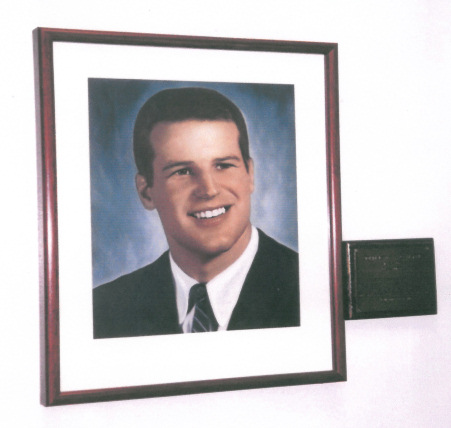
Plaque
Dedicated scholar, Creative Student Leader and Dreamer of Dreams
John found friends everywhere.
May his dreams find expression in those who knew and loved him.
|